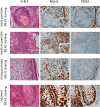Novel microsatellite instability test of sebaceous tumours to facilitate low-cost universal screening for Lynch syndrome
- PMID: 39847610
- PMCID: PMC12099064
- DOI: 10.1093/ced/llaf005
Novel microsatellite instability test of sebaceous tumours to facilitate low-cost universal screening for Lynch syndrome
Abstract
Background: One in five patients with sebaceous tumours (STs) may have Lynch syndrome (LS), an inherited disorder that increases the risk of developing cancer. Patients with LS benefit from cancer surveillance and prevention programmes and immunotherapy. While universal tumour mismatch repair (MMR) deficiency testing is recommended in colorectal and endometrial cancers to screen for LS, there is no consensus screening strategy for STs, leading to low testing rates and inequity of care.
Objectives: To assess a low-cost and scalable sequencing-based microsatellite instability (MSI) assay, previously shown to enhance LS screening of colorectal cancers, for MMR deficiency detection in STs against the current clinical standard of immunohistochemistry (IHC).
Methods: Consecutive ST cases (n = 107) were identified from the records of a single pathology department. MMR protein IHC staining was interpreted by a consultant histopathologist. MSI analysis used amplicon sequencing of 14 microsatellites and a naive Bayesian classifier to calculate the sample MSI score.
Results: Loss of MMR protein expression was observed in 49/104 STs with interpretable IHC [47.1%, 95% confidence interval (CI) 37.3-57.2]. MMR deficiency was less frequent in carcinoma than in adenoma and sebaceoma (P = 4.74 × 10-3). The majority of MMR-deficient STs had concurrent loss of MSH2 and MSH6 expression. The MSI score achieved a receiver operator characteristic area under curve of 0.944 relative to IHC. Lower MSI scores were associated with MSH6 deficiency.
Conclusions: These data support MSI testing as an adjunct or alternative to MMR IHC in STs. Integration of STs into established LS screening pathways using this high-throughput methodology could increase testing and reduce costs.
© The Author(s) 2025. Published by Oxford University Press on behalf of British Association of Dermatologists.
Conflict of interest statement
Conflicts of interest: R.G., M. S-K., M.S.J. and J.B. are named inventors on patents covering the microsatellite instability markers analysed: WO/2018/037231 (published 1 March 2018), WO/2021/019197 (published 4 February 2021) and GB2114136.1 (filed 1 October 2021). The other authors declare no conflicts of interest.
Figures



Similar articles
-
Comparison of screening strategies for Lynch syndrome in patients with newly diagnosed endometrial cancer: a prospective cohort study in China.Cancer Commun (Lond). 2019 Jul 15;39(1):42. doi: 10.1186/s40880-019-0388-2. Cancer Commun (Lond). 2019. PMID: 31307542 Free PMC article.
-
The proportion of endometrial tumours associated with Lynch syndrome (PETALS): A prospective cross-sectional study.PLoS Med. 2020 Sep 17;17(9):e1003263. doi: 10.1371/journal.pmed.1003263. eCollection 2020 Sep. PLoS Med. 2020. PMID: 32941469 Free PMC article.
-
Association of tumor morphology with mismatch-repair protein status in older endometrial cancer patients: implications for universal versus selective screening strategies for Lynch syndrome.Am J Surg Pathol. 2014 Jun;38(6):793-800. doi: 10.1097/PAS.0000000000000177. Am J Surg Pathol. 2014. PMID: 24503759
-
The Clinical Outcomes Among Patients Under 60 Years Old with Lynch Syndrome: Variations Based on Different Mutation Patterns.Int J Mol Sci. 2025 Apr 4;26(7):3383. doi: 10.3390/ijms26073383. Int J Mol Sci. 2025. PMID: 40244260 Free PMC article. Review.
-
Mismatch Repair Screening of Gastrointestinal Cancers: The Impact on Lynch Syndrome Detection and Immunotherapy.J Gastrointest Cancer. 2023 Sep;54(3):768-775. doi: 10.1007/s12029-022-00859-3. Epub 2022 Aug 26. J Gastrointest Cancer. 2023. PMID: 36018445 Free PMC article. Review.
References
-
- Ferreira I, Wiedemeyer K, Demetter P et al. Update on the pathology, genetics and somatic landscape of sebaceous tumours. Histopathology 2020; 76:640–9. - PubMed
-
- Schon K, Rytina E, Drummond J et al. Evaluation of universal immunohistochemical screening of sebaceous neoplasms in a service setting. Clin Exp Dermatol 2018; 43:410–15. - PubMed
-
- Cook S, Pethick J, Kibbi N et al. Sebaceous carcinoma epidemiology, associated malignancies and Lynch/Muir-Torre syndrome screening in England from 2008 to 2018. J Am Acad Dermatol 2023; 89:1129–35. - PubMed
MeSH terms
Substances
Grants and funding
LinkOut - more resources
Full Text Sources
Miscellaneous

